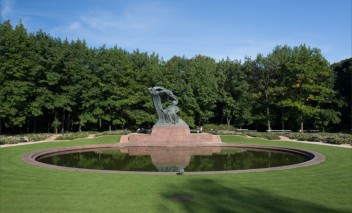Climate change and the trees at the Royal Łazienki

The impacts of recent climate change have become particularly acute for the historic gardens of the Royal Łazienki Museum. Due to a warmer and drier climate, and strong winds, the protection of the historic vegetation cover has become increasingly challenging.
The historic gardens of the Royal Łazienki Museum are one of the most beautiful and valuable natural and cultural sites in Europe. The origins of the tree stand date back to the period falling shortly after Stanisław August acquired the Ujazdowski estate. However, there are probably not many trees left from the time of the last king of Poland. Specimens that are approximately 200-240 years old include two pedunculate oaks from the Romantic Garden (nature monuments), the common ash at the Belvedere Pond and the European larch by the Water Tower. These trees may be genuine witnesses to the origins of the Royal Łazienki.
Condition of the Łazienki dendroflora
Presently, the Łazienki Gardens count around 325 species and varieties of trees and shrubs, of which the trees themselves account for roughly 9,500. The rich dendroflora favours the preservation of biodiversity and provides a valuable natural area in the city centre.
However, for several years now, in the Łazienki Gardens we have seen adverse phenomena which have a negative impact on native woody species, characteristic of the northern hemisphere and temperate climates. The condition of the trees is adversely affected by deteriorating habitat conditions and, in particular, climatic conditions, namely rising temperatures and lower rainfall levels during the growing season.
How is the Łazienki dendorflora changing? Conifers, which tolerate air pollution or hydrological disturbance less well, and more sensitive deciduous species, such as the elm tree, gradually disappear. Another example is the Lombardy poplar, which is typical of the era of Stanisław August. Its restoration in present times under conditions of excessive parkland tree cover has become problematic (the Lombardy poplar needs more of an open space).
Because of rainfall deficits and the soil moisture evaporation most of the trees in the Łazienki gardens show signs of water deficiency. Rust-coloured, bacterial growth can be observed on the trunks of maple trees; it is an indication of falling groundwater levels. Increasing drought is delaying the vegetation of the European ash and the black alder, among others, and the leaves of water-sensitive small-leaved lindens, the Norway maples and the horse chestnut trees are drying up and falling off. Climate change also leads to the emergence of new pathogens and pests. Chestnut trees are under threat from the disease known as chestnut blight and the horse-chestnut leaf miner.
Protection of historical vegetation
Due to a warmer and drier climate and strong winds, the protection of the historic vegetation cover has become increasingly challenging. The July storm destroyed the stand of trees on an unprecedented scale (over 100 windthrows and tree debris). In the process of damage restoration follow-up analyses were carried out to ensure a balance between care for the historic space and the safety of visitors and staff.
One of the solutions which was implemented is the exclusion of some of the lawns from use in order to improve soil properties and the conditions of plant habitat. The lawns help prevent erosion and improve water retention, which has a significant impact on the entire ecosystem of the historic gardens of the Royal Łazienki Museum.





